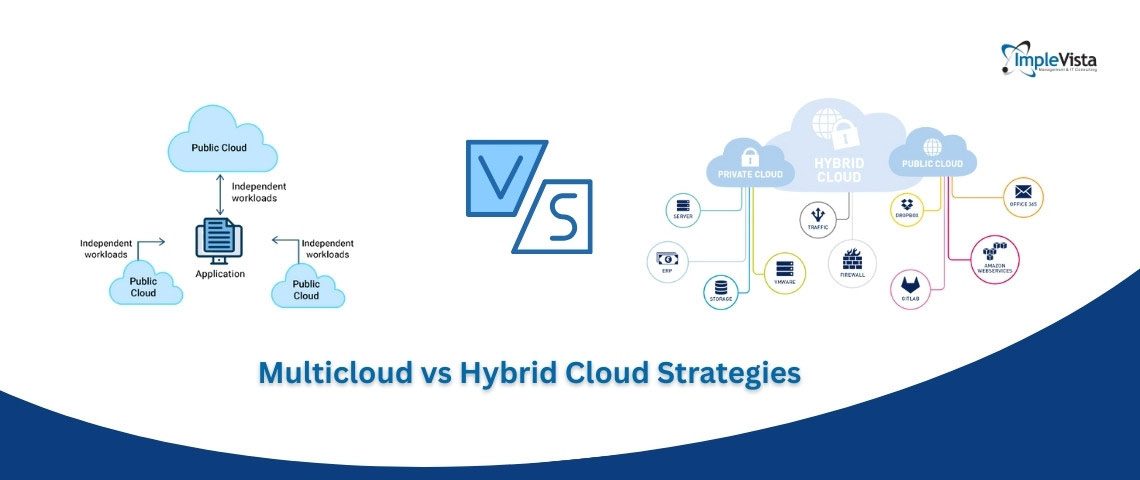Cloud computing has revolutionized how businesses operate, and small and medium enterprises (SMEs) in Bangladesh are catching up fast. Companies in Dhaka and beyond are leveraging cloud applications to enhance customer experiences, drive efficiency, and unlock new revenue.
However, with multiple cloud deployment models emerging, many SMEs face a key question: should we go with a hybrid cloud setup (mixing private and public clouds) or adopt a multi-cloud strategy (using multiple public clouds)? In this comprehensive guide, we’ll break down the differences, pros and cons, and real-world considerations for Bangladeshi SMEs in 2025, so you can pick the optimal cloud strategy for your business.
What Is Hybrid Cloud and MultiCloud?
Both hybrid cloud and multi-cloud involve multiple cloud environments, but they mean slightly different things. A hybrid cloud setup combines on-premises (private) infrastructure with one or more public clouds (like AWS or Azure) in an integrated framework. This gives businesses flexibility to run sensitive workloads locally while bursting to the public cloud when needed.
In contrast, a multi-cloud approach uses more than one public cloud provider for workloads. You might use AWS for your website and Google Cloud for data analytics, for example. VMware clarifies it simply: “Hybrid clouds always include a private cloud… Multi-clouds always include more than one public cloud service.”
The key distinction is that hybrid clouds integrate a private cloud, whereas multi-cloud focuses on multiple public clouds. In practice, a company could even have a hybrid multi-cloud environment (if it uses a private cloud plus several public clouds). As TierPoint notes, “a hybrid cloud strategy may include multiple clouds, but a multicloud strategy isn’t necessarily hybrid.” Understanding this difference is the first step to choosing the right model for your SME.
Why Multicloud vs Hybrid Cloud Matters for SMEs
SMEs often have limited IT budgets and teams, so picking the right cloud model can make a big impact. Each approach offers distinct benefits:
- Hybrid Cloud Computing gives you control and compliance. By keeping core data on local servers (private cloud), you can meet regulatory or data locality needs while still taking advantage of public clouds for scale. For example, Bangladesh’s new data privacy law (inspired by GDPR) is expected to require “data mirroring” – meaning businesses must keep a local copy of customer data. A hybrid setup easily accommodates this: sensitive data stays on a private cloud in Bangladesh, while other workloads run on AWS/Azure for scalability.
- Multi-Cloud offers flexibility and innovation. By using multiple public clouds, you avoid vendor lock-in and can pick the best services from each provider. For instance, one provider might offer the best machine learning tools, while another excels in database or network pricing. As Implevista’s cloud computing blog explains, leveraging multiple cloud providers can “enhance performance and minimize the risks associated with vendor lock-in”. This can be vital for SMEs looking to stay agile and avoid reliance on a single vendor.
In 2025, hybrid and multi-cloud are both mainstream: industry data shows 54% of organizations now use hybrid models, and surveys suggest up to 92% of companies plan multi-cloud strategies. The choice isn’t always one-or-the-other: some SMEs may even do both (e.g. a private cloud plus two public clouds). The important part is understanding the trade-offs for your business.

Advantages of Hybrid Cloud for SMEs
Hybrid cloud computing combines the best of both worlds: local control and cloud scale. Here are the main benefits of a hybrid cloud setup, especially for small businesses in Bangladesh:
- Control over Sensitive Data: Sensitive customer or financial data can be kept in a private cloud (on-premises or hosted locally). This is crucial if you have compliance concerns or future data localization laws. You maintain full control of that critical data, reducing security and privacy risks.
- Regulatory Compliance: As noted, Bangladesh’s draft data privacy law mandates local data storage. A hybrid cloud allows you to store regulated data on local servers (meeting the requirement) while still using public clouds elsewhere. This makes it easier to comply with local regulations (like the Digital Security Act) and industry standards.
- Performance and Low Latency: On-premises infrastructure can serve users with minimal latency. For applications that require real-time processing or low delay (like local e-commerce or manufacturing systems), keeping compute close to users improves performance.
- Cost Optimization: You can run stable, predictable workloads on your existing servers (reducing public cloud costs) while bursting to the cloud for seasonal spikes. For an SME, this hybrid approach can optimize cloud bills by only paying for extra capacity when needed.
- Incremental Cloud Adoption: Many SMEs are new to cloud. Hybrid lets you migrate gradually. You can move non-critical apps to the cloud first, leaving legacy or complex systems on-prem. This step-by-step approach reduces risk and learning curve.
These hybrid benefits are noted by cloud experts. For example, a lead in VMware’s blog points out that hybrid clouds include both public and private clouds to provide a flexible mix of services. This flexibility is exactly why many businesses (especially those with legacy systems) adopt hybrid strategies.
Drawbacks of Hybrid Cloud
Hybrid cloud isn’t a silver bullet; there are trade-offs:
- Complex Infrastructure: Managing both local data centers and cloud environments can be complex. Your IT team (or managed service provider) must handle networking, integration, and security across two worlds.
- Vendor Lock-In: A hybrid approach might involve relying heavily on one public cloud vendor. If you don’t also do multi-cloud, you could still get locked into that provider’s ecosystem. TierPoint notes that “vendor lock-in may be more common in hybrid cloud environments where businesses are only using one public cloud provider”.
- Upfront Costs for Private Cloud: You need to invest in local infrastructure (servers, virtualization) or pay for a private cloud service. For very small SMEs, this might be a significant capital expense.
- Integration Effort: Connecting on-premises systems to cloud services requires effort (e.g., setting up VPNs, gateways, or hybrid management tools). Ensuring seamless data flow and unified management can take time.
- Maintenance of On-Premises Resources: Even in a hybrid model, some responsibility remains for maintaining hardware, cooling, backups, etc. This can be a drawback compared to fully managed public cloud.
Overall, hybrid cloud gives you power and control, but at the cost of added complexity and some investment. For many Bangladeshi SMEs with critical on-site data, the pros outweigh the cons, but it depends on each business’s priorities.

Advantages of Multi-Cloud for SMEs
Multi-cloud means using two or more public cloud providers together. Here’s why some SMEs might prefer multi-cloud:
- Avoiding Vendor Lock-In: You’re not tied to one provider. If pricing or service quality suffers with one vendor, you can move or split workloads to another. This flexibility can lead to better deals and the ability to negotiate.
- Best-of-Breed Services: Different clouds have unique strengths. For instance, you might use Google Cloud’s AI/ML tools, Microsoft Azure’s integration with Office software, and AWS’s broad infrastructure. This lets SMEs use the best tools for each task.
- High Availability and Redundancy: By distributing workloads across clouds, you reduce the risk of downtime. If one cloud has an outage, others can pick up the slack. This is crucial for businesses that need their services online 24/7 (like e-commerce or payment systems).
- Global Reach and Performance: Some providers have better data center coverage in certain regions. Using multiple clouds lets you serve customers from the nearest region of any provider, improving speed.
- Scalability on Demand: Multi-cloud can help manage unpredictable growth. If one cloud limit is reached, you can scale seamlessly into another cloud without waiting for more capacity.
- Leveraging Cloud Innovations: Each cloud provider is constantly releasing new services. A multi-cloud strategy means your SME can adopt innovation faster (e.g., new AI tools, serverless features, security services) without waiting for your single provider.
This flexibility and innovation-driven approach is exactly what many growing tech companies do. As the Implevista blog on future cloud trends notes, leveraging multi-cloud setups can meet different needs and minimize vendor lock-in. For a competitive SME, these are powerful advantages.
Drawbacks of Multi-Cloud
However, multi-cloud brings its own challenges:
- Management Complexity: You now must manage multiple accounts, interfaces, and billing systems. Tracking usage and optimizing costs across several clouds is non-trivial.
- Skill Requirements: Your IT team needs skills for each cloud platform (AWS, Azure, GCP, etc.). SMEs might need to train staff or hire consultants to handle multiple environments.
- Networking Overhead: Connecting clouds (and connecting users to the right cloud region) requires careful network design. Egress costs (data transfer out of cloud) can add up if not planned.
- Security Consistency: Each cloud has its own security tools and models. Ensuring consistent security policies across them can be tricky.
- Cost Overhead: While multi-cloud can optimize cost by choosing providers, it can also increase complexity in billing. Without strong controls, costs can grow if multiple clouds are left running.
- Data Management: If you keep copies of data in two clouds (for redundancy), you need processes to keep them in sync and avoid data fragmentation.
These challenges mean SMEs adopting multi-cloud should invest in automation and monitoring. Fortunately, there are specialized tools known as multi-cloud management platforms that help orchestrate resources across providers (more on that in the next section). But even with tools, some complexity remains.

Choosing Between Hybrid and Multi-Cloud: Key Considerations
How should a Bangladesh SME decide which model to use? Some factors to weigh:
- Workload Sensitivity: If you handle highly sensitive data (e.g. financial records, patient info), hybrid might be safer for core workloads, because you can keep that data on-prem. Use public clouds for less-sensitive work.
- Regulatory Requirements: Bangladesh is moving toward strict data laws. A hybrid solution with local servers can ensure compliance (as [6] suggests). If regulations ease or you find local cloud providers, multi-cloud may be safer.
- Budget and Resources: SMEs with limited budget and no data center might favor pure public cloud or multi-cloud. Those with existing on-prem assets may augment them (hybrid).
- IT Expertise: Do you have staff or partners who know multiple clouds? If not, starting with one cloud (even if “multi” on paper you only eventually use one) might be easier. Hybrid requires integrating on-prem tech.
- Vendor Negotiation: Using multiple clouds gives bargaining power. If avoiding lock-in is a priority, multi-cloud appeals.
- Business Continuity Needs: If downtime of a single provider would cripple you, multi-cloud or hybrid (or both) adds redundancy.
- Local Infrastructure: Bangladesh has ~77 million internet users and expanding 4G/broadband, making global clouds more accessible. However, connectivity reliability in rural areas may still push businesses to use some local (private) infrastructure.
To summarize: Hybrid cloud is generally chosen when control, legacy systems, or compliance is paramount, while multi-cloud is chosen for flexibility, redundancy, and leveraging best-of-breed services. Many SMEs might adopt a hybrid multi-cloud strategy, running some parts on-prem and some on multiple clouds.
Multi-Cloud Management Platforms
If you go multi-cloud (or hybrid), you’ll likely need tools to manage the sprawl. A multi-cloud management platform is software that provides a unified interface to deploy, monitor, and secure resources across different clouds. These platforms can handle tasks like cost tracking, security policy enforcement, and workload orchestration across providers.
TierPoint points out that multicloud environments often “require additional processes and tools for interoperability”. For example, a platform could automate the creation of virtual machines simultaneously on AWS and Azure, or consolidate usage reports into one dashboard. Tools like Terraform, Kubernetes, or commercial cloud management systems fall into this category. Using such a platform helps SMEs avoid the pitfall of managing clouds in silos. It also simplifies implementing consistent security policies and autoscaling policies across clouds.
In short, if you’re serious about multi-cloud, investing in a management platform (or service) is wise. It can make your operation feel more like a single seamless system rather than a tangle of separate clouds.
Case Examples for Bangladeshi SMEs
While we don’t have public case studies of specific Bangladeshi startups switching cloud models, we can imagine typical scenarios:
- Local E-Commerce Startup: Suppose an online retailer in Dhaka handles many transactions daily. They might use AWS for their website (for reliability and scalability) and Google Cloud for data analytics on customer data – a multi-cloud setup. For payment processing and customer data, they might still use a private cloud or managed database in Bangladesh to comply with local data rules. Here they’re essentially using both models.
- Mid-Sized Manufacturer: A garment factory with an in-house IT team could have an ERP system on a private cloud inside their factory and use Microsoft Azure for collaboration and remote monitoring of machinery. They would benefit from hybrid cloud’s control for production data, and Azure’s services for offsite tasks.
- Fintech or Banking SME: Given strict finance regulations, a fintech might keep all transaction data on a private cloud (hybrid) but use AWS or Azure disaster recovery and analytics tools in the public cloud. This hybrid approach ensures compliance with the Bangladesh Bank requirements while still innovating.
- Agri-Tech Startup: A company using IoT sensors in rural areas might deploy multi-cloud to take advantage of the nearest datacenter for processing, switching between Google Cloud, AWS, or even Alibaba Cloud depending on network latency. They can also store only aggregated data on local private cloud for offline compliance backup.
The common thread is that Bangladeshi SMEs should tailor the mix. If connectivity in their area is excellent, multi-cloud is easier. If their customers demand strong privacy or have strict government regulations, hybrid will likely dominate their strategy.
Implevista’s own services, such as Cloud Engineering, can help design and implement these architectures. By assessing your needs, Implevista can guide you to the ideal mix. See Implevista’s step-by-step cloud migration strategy guide for one framework.
Conclusion
Choosing between multicloud and hybrid cloud isn’t about which is “better” universally – it’s about what’s right for your SME in Bangladesh. Hybrid cloud offers control, compliance, and smooth migration of legacy systems, while multi-cloud offers innovation, redundancy, and bargaining power. In 2025, the majority of forward-looking businesses will likely use both to some extent.
For Bangladeshi SMEs, consider factors like data regulations (e.g. new data localization laws), connectivity, budget, and expertise. Talk to experienced cloud consultants (like Implevista’s team) to map out a cloud strategy. And remember: whether hybrid or multicloud, robust security and management tools are key to success.
Ready to transform your SME with the right cloud strategy?
Contact Implevista’s cloud experts today to discuss your needs. Explore our Cloud Engineering services for tailored solutions, or reach out for a consultation. Subscribe to our blog for more insights and case studies on cloud computing, or check out our 7-step Cloud Migration Strategy guide to get started.

FAQs about Multicloud vs Hybrid Cloud
Q: What is hybrid cloud computing?
A: A hybrid cloud combines private (on-premises or hosted) infrastructure with public cloud services, forming a unified system. It allows businesses to run sensitive workloads on their own servers while offloading other tasks to public clouds.
Q: What is multi-cloud computing?
A: Multi-cloud refers to using two or more public cloud providers for different workloads. For example, a company might use AWS for databases and Google Cloud for machine learning. Multi-cloud setups improve flexibility and reduce reliance on one vendor.
Q: How do hybrid and multi-cloud differ?
A: The main difference is a private cloud presence: hybrid cloud always includes a private cloud plus at least one public cloud, while multi-cloud uses multiple public clouds (and may or may not include a private cloud). In short, hybrid = private + public; multi-cloud = multiple publics.
Q: What are the benefits of a hybrid cloud for SMEs?
A: Hybrid cloud offers data control and compliance (keep core data in-house), local performance (on-premises speed), and cost control by using existing infrastructure. It’s ideal if you have legacy systems or regulatory requirements.
Q: What are the benefits of a multi-cloud for SMEs?
A: Multi-cloud provides flexibility and innovation: you can pick the best cloud service for each need, avoid vendor lock-in (more negotiation power), and improve uptime by distributing workloads across clouds. It’s great for tech-driven SMEs that want rapid scaling and resilience.
Q: What are the main drawbacks of multi-cloud?
A: Managing multiple cloud accounts is complex. It requires skilled IT resources or tools to handle different platforms, unify security policies, and control costs. Data synchronization and networking between clouds can also be challenging.
Q: Which is better for a small business: hybrid or multi-cloud?
A: There’s no one-size-fits-all answer. If your SME has critical data or regulatory needs in Bangladesh, hybrid cloud may be safer. If your focus is agility and leveraging diverse cloud features, multi-cloud could win. Many SMEs combine both approaches (for example, on-prem + AWS + GCP). Evaluate your workloads, budget, and compliance needs before deciding.
Q: What is a multi-cloud management platform?
A: It’s a tool or service that lets you manage resources across different clouds from one interface. These platforms help automate deployment, monitor usage, and enforce policies on AWS, Azure, GCP, etc., as if they were a single environment. Using one can simplify the complexity of a multi-cloud strategy.
Q: How do data laws in Bangladesh affect cloud choice?
A: Bangladesh’s upcoming Data Protection Act will require businesses to store a local copy of personal data. This pushes SMEs toward hybrid cloud or local cloud solutions to comply. In practice, you might keep data in a private local cloud while still using public clouds for other services.
Q: Can a company implement both multi-cloud and hybrid cloud?
A: Yes, a hybrid multi-cloud is possible. For example, a business might have a private cloud in its office (hybrid) and also use AWS and Azure (making it multi-cloud as well). TierPoint notes that hybrid and multi-cloud strategies can overlap: you could be in a hybrid environment that spans multiple public clouds. This gives maximum flexibility, though it’s also the most complex to manage.




